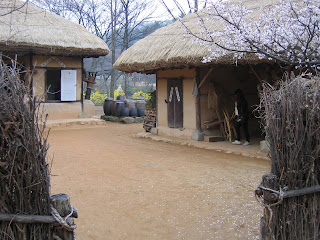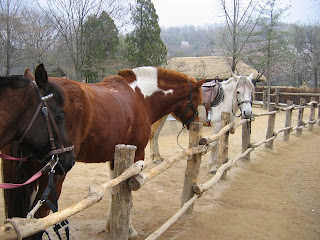 The Korean Folk Village, located just outside of Seoul, consists of over 200 acres of traditional housing and culture found in the later Joseon Dynasty. We're not talking that long ago -- the Joseon Dynasty ended in 1910 when the Japanese began to rule Korea (1910-1945). If you're on the lookout, similar articles and methods used during this era can still be found through regions of Korea today.
The Korean Folk Village, located just outside of Seoul, consists of over 200 acres of traditional housing and culture found in the later Joseon Dynasty. We're not talking that long ago -- the Joseon Dynasty ended in 1910 when the Japanese began to rule Korea (1910-1945). If you're on the lookout, similar articles and methods used during this era can still be found through regions of Korea today.

It's an understatement to say that kimchi is a 'staple' in the Korean culture. The earliest form of kimchi was made of only fermented cabbage some 2600 years ago, and it was in the 12th century when people began to include other spices to create different flavors, such as sweet and sour flavors, and colors of kimchi, such as white and orange. No surprise then, that the Korean village replica was strewn with kimchi pots. These pots are visible only for a time -- when they are filled with cabbage they are buried underground for a few months to help the fermentation process. I'm not a huge kimchi fan but I must admit that I like when they make stew out of it, called kimchi chiggae.


Today Korean kimchi is mass-produced to meet the demand of a growing population. The average Korean home will store it in refrigerators with specially designed compartments for easy access -- kimchi for breakfast, lunch and dinner! Trust me, I haven't seen a table set for a meal in Korea without kimchi and many other side dishes, like pickled radish and garlic.
 The village has attractions for those not so historically inclined. Adults and kids alike have access to amusement and horse rides along with other outdoor entertainment. Unfortunately our time was cut short so don't be surprised when I suggest we go to the Korean Folk Village when you come to South Korea for a visit =)
The village has attractions for those not so historically inclined. Adults and kids alike have access to amusement and horse rides along with other outdoor entertainment. Unfortunately our time was cut short so don't be surprised when I suggest we go to the Korean Folk Village when you come to South Korea for a visit =)


